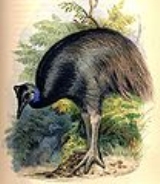
Dwarf Cassowary
Encyclopedia
The Dwarf Cassowary, Casuarius bennetti, also known as the Bennett's Cassowary, Little Cassowary, Mountain Cassowary, or Mooruk, is the smallest of the three species of cassowaries
.
The Karam of the New Guinea Highlands identify bats and flying birds as one classification (yaket), and the Dwarf Cassowary, an extremely large wingless, flightless bird as another classification (kobtiy). Whereas yaket are bony with wings and fly in the air, kobtiy are bony without wings and are terrestrial and of the forest. Kobtiy are different from other bony wingless animals in that the kobtiy are not quadrupedal, like dogs and lizards, and are not limbless, like snakes.
John Gould
first identified the Dwarf Cassowary from a specimen from New Britain
, in 1857.
, New Britain
, and Yapen Island, at elevations up to 3300 m (10,826.8 ft). In areas without other species of cassowaries, it will live in the lowlands also. Its diet consists mainly of fallen fruits and small animals, and insects. A solitary bird, it pairs only in breeding season.
of Threatened Species, with an occurrence range of 258000 km² (99,614.4 sq mi).
Cassowary
The cassowaries are ratites, very large flightless birds in the genus Casuarius native to the tropical forests of New Guinea, nearby islands and northeastern Australia. There are three extant species recognized today...
.
Taxonomy
The scientific name commemorates the Australian naturalist George Bennett. He was the first scientist to examine these birds after a few were brought to Australia aboard a ship. Recognising them as representing a new species of cassowary, he sent specimens back to England where this was confirmed. On the west side of Geelvink Bay, western Irian, there exist a distinctive form that may merit a split. C. papuanus is the tentative name. Finally there are no officially recognized sub-species, however, some authors believe there should be.The Karam of the New Guinea Highlands identify bats and flying birds as one classification (yaket), and the Dwarf Cassowary, an extremely large wingless, flightless bird as another classification (kobtiy). Whereas yaket are bony with wings and fly in the air, kobtiy are bony without wings and are terrestrial and of the forest. Kobtiy are different from other bony wingless animals in that the kobtiy are not quadrupedal, like dogs and lizards, and are not limbless, like snakes.
John Gould
John Gould
John Gould was an English ornithologist and bird artist. The Gould League in Australia was named after him. His identification of the birds now nicknamed "Darwin's finches" played a role in the inception of Darwin's theory of evolution by natural selection...
first identified the Dwarf Cassowary from a specimen from New Britain
New Britain
New Britain, or Niu Briten, is the largest island in the Bismarck Archipelago of Papua New Guinea. It is separated from the island of New Guinea by the Dampier and Vitiaz Straits and from New Ireland by St. George's Channel...
, in 1857.
| Location | Population | Trend |
| Central Papua New Guinea Papua New Guinea Papua New Guinea , officially the Independent State of Papua New Guinea, is a country in Oceania, occupying the eastern half of the island of New Guinea and numerous offshore islands... |
Unknown | Declining |
| New Britain New Britain New Britain, or Niu Briten, is the largest island in the Bismarck Archipelago of Papua New Guinea. It is separated from the island of New Guinea by the Dampier and Vitiaz Straits and from New Ireland by St. George's Channel... |
Unknown | Declining |
| Yapen Yapen Yapen is an island of western New Guinea, Indonesia. The Yapen Strait separates Yapen and the Biak Islands to the north. It is in Cenderawasih Bay. To the west is Mios Num Strait between it and Mios Num Island, and the east Kurudu Island. The southeast are the Amboi Islands and the southwest... |
Unknown | Declining |
| Total | Unknown | Moderately Declining |
Description
It is large, at between 99 to 135 cm (3.2 to 4.4 ft) tall and 18 kilograms (39.7 lb), flightless bird with hard and stiff black plumage, a low triangular casque, pink cheek and red patches of skin on its blue neck. The feet are large and powerful, equipped with dagger-like claws on the inner toe. Both sexes are similar. Females have longer casques, brighter bare skin color and are larger in size.Range and habitat
The Dwarf Cassowary is distributed throughout mountain forests of New GuineaNew Guinea
New Guinea is the world's second largest island, after Greenland, covering a land area of 786,000 km2. Located in the southwest Pacific Ocean, it lies geographically to the east of the Malay Archipelago, with which it is sometimes included as part of a greater Indo-Australian Archipelago...
, New Britain
New Britain
New Britain, or Niu Briten, is the largest island in the Bismarck Archipelago of Papua New Guinea. It is separated from the island of New Guinea by the Dampier and Vitiaz Straits and from New Ireland by St. George's Channel...
, and Yapen Island, at elevations up to 3300 m (10,826.8 ft). In areas without other species of cassowaries, it will live in the lowlands also. Its diet consists mainly of fallen fruits and small animals, and insects. A solitary bird, it pairs only in breeding season.
Conservation
Due to ongoing habitat loss, habitat degradation, being hunted for food, and often being kept in captivity, the Dwarf Cassowary is evaluated as Near Threatened on the IUCN Red ListIUCN Red List
The IUCN Red List of Threatened Species , founded in 1963, is the world's most comprehensive inventory of the global conservation status of biological species. The International Union for Conservation of Nature is the world's main authority on the conservation status of species...
of Threatened Species, with an occurrence range of 258000 km² (99,614.4 sq mi).

